Looks as though I’m done testing for a while.
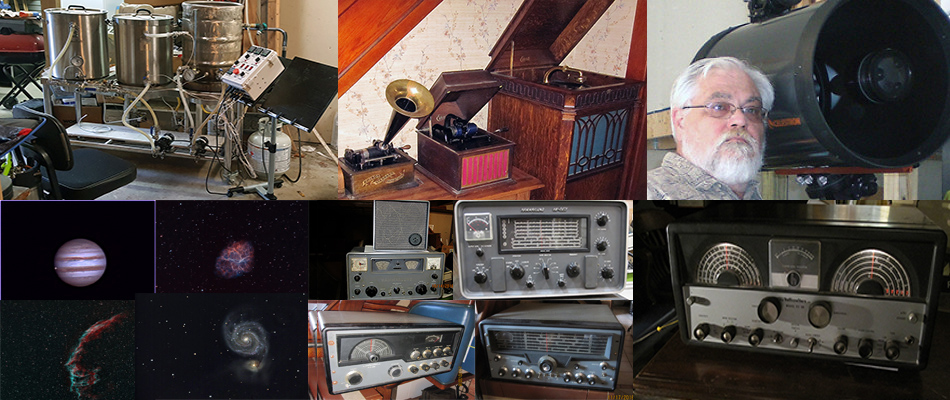
Grabbed another 1 hour image tonight.
Fullsize version at http://www.cloudynights.com/photopost/showphoto.php?photo=27575&size=big
Clear sky, light wind, good transparency, and no Moon. If it were a weekend I’d have gotten a lot done tonight. As it is, I have to be in the office tomorrow morning and I’ve already stayed up too late. Checked the seeing just before I shut down and my urban surroundings (plenty of asphalt, concrete, brick, etc.) were still dumping lots of heat. Translates to big stars (FWHM around 3 arcseconds) in long exposures and dancing stars in short exposures. No use trying to record tracking errors with the centroid moving around on its own but I can image if I can live with fat stars and some funky star shapes. I gave Starlock a star below 30 degrees declination this time (the handbox warns if using one farther from the celestial equator but I’ve been ignoring it) and let it set up the guide rates (ended up 16 and 10) and then cleared PEC and trained it and added one update run. Chose M51 as a target because it’s near zenith (reduced seeing effects) and because it is in a star-poor region; I wanted to see if Starlock could find something on which to guide. It did, and seemed to work well.
Talked to the guys at Meade today and was told not to read too much into the recorded pec data; I’ll have to wait for good skies to evaluate tracking. I might still be within the 10 arcsecond p-p some are reporting.
SO – here’s what I got tonight in about 90 minutes of shooting LRGB. Larger version is at http://www.cloudynights.com/photopost/showphoto.php?photo=27559&size=big
-edit- Fixed the star shapes; shouldn’t try to stack images at 3:00am! Accidentally left the blue frames unselected when aligning in CCDStack2. Fixing that made the stars round plus improved detail generally.
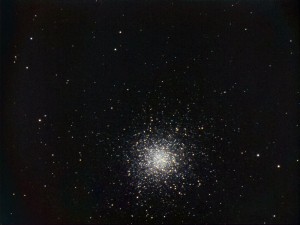 First, a little news. Meade has issued firmware updates for both the mount and the Starlock module, and also an updated version of the PEC editor. My router still blocks only one site (Meade) so I had to download it all at the office and drag it home. Eventually I’ll make fixing that a priority. All installed, all working fine. Bigger news is that JOC (Meade’s primary supplier of imported products for many years) proposes to buy control. The stockholders should surely approve this; it would result in a serious cash injection for Meade and ensure their survival for quite a while.
First, a little news. Meade has issued firmware updates for both the mount and the Starlock module, and also an updated version of the PEC editor. My router still blocks only one site (Meade) so I had to download it all at the office and drag it home. Eventually I’ll make fixing that a priority. All installed, all working fine. Bigger news is that JOC (Meade’s primary supplier of imported products for many years) proposes to buy control. The stockholders should surely approve this; it would result in a serious cash injection for Meade and ensure their survival for quite a while.
I used the PEC editor to look at the PEC data stored in the mount. It’s a little disappointing; looks like maybe 16 p-p arcseconds uncorrected PE. I’ll call Meade about that at some point. PPEC and Starlock seem to be managing that pretty well, though.
Meanwhile, another quickie test image shot through cloud openings. The Moon was up for the later exposures so had to do some equalization to keep the stars above the background light. CCDStack2 is an excellent program that handles that very well. Only 100 second exposures because I had to get some data before the clouds took over completely.
A larger and less compressed version can be seen here: http://www.cloudynights.com/photopost/showphoto.php?photo=27541&size=big
The Clear Sky Chart predicted no clouds, poor transparency, and wind (17-28 mph). As usual for my location, it was about right. I shot M81 anyway, but between the wind and the poor transparency it wasn’t much good. I don’t know whether my old Tak NJP would have done any better, but I suspect it might have. Had to throw away several frames; it’s been a long time since I did that. The Astrotech 12″ RC is a pretty big sail in my rolloff. Would have been OK in a dome, I guess. I see that Astrotech is going to bring out truss tube versions of their 10″, 12″, and 16″ RC models next year. Something to ponder!
Bigger version of that image here: http://www.cloudynights.com/photopost/showphoto.php?photo=27582&size=big
I saw a photo today of a more recently received LX850 mount and they have made a couple of small changes. The new mounts have a compass mounted to the base, and the elevation axis is not blue. I’ll be selling this one off next year or the year after that and now it’ll be the “old model”, which won’t help. Bummer.
Here we go. Trying to use the mount’s features as though I had no imaging experience. Assisted drift alignment, auto guide calibration, auto PEC train, Starlock guiding. Anyone would be able to do these procedures. Then I picked an easy target (Moon about to rise) and started shooting. The image has flaws; AT12RC needs to be collimated, for one thing. FWHM was nearly 3 arcseconds in short focus exposures. The mount, though, appears to have done a good job; FWHM didn’t increase much on longer exposures; just enough to account for seeing variations. There were no discarded light frames. When I get the FWHM down below 2 arcseconds we’ll get a more rigorous test of tracking.
You can see a larger version here: http://www.cloudynights.com/photopost/showphoto.php?photo=27431&size=big
The observatory PC was down so I couldn’t operate any cameras – thus, no tracking error could be quantified. I did use the assisted polar alignment. Couldn’t start with PolarAlignMax as usual because of the PC so I just plopped it down and let the mount sort it out. That took longer than it would have if I had started a little closer to correct alignment, but it got me there. You can tell how far off you are by how long it watches the drift. When I started it was using periods of 20 seconds but by the time I was done it took 90 seconds or more to see enough drift to decide what to do. I really like the whole “turn knob .5 turns CW” bit! Both adjustments are very smooth and precise; I believe they are both worm drives. I’ll refine it later but it should be close enough now for reliable goto. I did a star alignment or two, just looking in the finderscope, and that seemed to work. I had the impression from reading the manual that the mount could do the alignment itself using the widefield Starlock camera but I didn’t figure out how to tell it to do that. I did observe the Starlock tracking camera going active and reporting tracking corrections so that appears to be working. That’s the camera it uses for drift, also. I don’t think I’ve done anything that used the widefield camera yet. I’ll turn on HPP next time I use the mount and see if that invokes the automatic object centering.
It seems nice and quiet now. I suppose it’s a combination of getting used to it, the gears wearing in a bit, and having it somewhere near balance. It’s nice (though not important) that it slews faster than the NJP.
I did get the PC running yesterday and installed the software from one of the disks. It came with three, for some reason, but the first one I grabbed seemed to have everything on it and until I check I’ll presume that they are all dupes. Don’t forget the drivers for the included serial-USB converter. I thought it was nice that they included that device, which presumably has been tested and found to be compatible with the controller. I’ve never had issues with serial-USB adaptors but have heard enough stories to know that it CAN be a problem.
Further testing under the stars will be arranged as time and weather permit. I’m eager to see some tracking results, and some test images!
It’s bolted down and cables routed. It started raining so I had to stop and close up but it’s nearly ready for use. Anyone wanting to install one of these things onto a pier should know two things. First: it is MUCH easier to manage with that huge saddleplate removed (especially if your observatory is on the second floor!). You need to pull that plate anyway to run cables through the mount. Cables with larger connectors (such
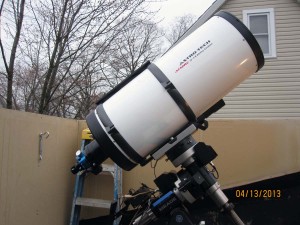
as Robofocus motor cables or USB cables) can’t come out the exposed opening unless you take more things apart. There’s a hole at the front for the declination motor cable, though, and that can be used to get those cables at least partially inside. Second: all that is required is a flat plate on the pier top with an accessible 1/2″ hole. A 1/2″ X 13tpi bolt goes up into the base and that’s what holds the mount.
I saw that some folks were mounting smallish refractors to the Starlock saddle and was hoping to cheat the FSQ-106N the same way, as I use a smaller-diameter OTA than they do. Sadly, there’s not enough room. The FSQ will have to go on top and that means the mount will get a real test. That’s a lot of weight to mount so far from the axis. Requires disproportionately more counterweight, too. Fortunately, I bought three extra counterweights ahead of time, just in case…
I found the 26 pound counterweights harder to thread onto the C/W shaft than the 14 pound Takahashi weights but no real problem there.
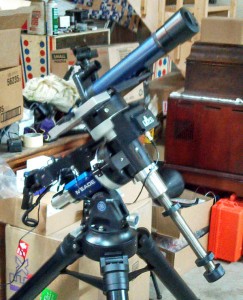
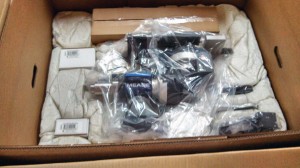
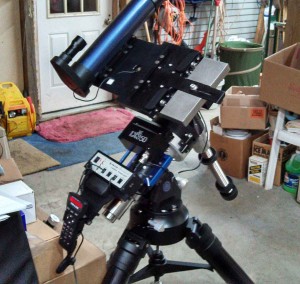 Got it assembled in the barn, on the tripod. They do still use a 1/2 X 13 center bolt so it will go onto my pier with no issues, but I may have to hire a crane to get it upstairs. If this mount is, as folks keep claiming, a Mach1 clone, then I admire the Hell out of anyone who uses a Mach1 in the field. I’m sure it is heavier than the NJP I just dragged downstairs (Well, I made Freddy drag it downstairs. I did take it off the pier.). It was all I could do get it out of the box and onto the tripod, with the tripod set very low (it is short, like the later cut-down Giant Field Tripods).
Got it assembled in the barn, on the tripod. They do still use a 1/2 X 13 center bolt so it will go onto my pier with no issues, but I may have to hire a crane to get it upstairs. If this mount is, as folks keep claiming, a Mach1 clone, then I admire the Hell out of anyone who uses a Mach1 in the field. I’m sure it is heavier than the NJP I just dragged downstairs (Well, I made Freddy drag it downstairs. I did take it off the pier.). It was all I could do get it out of the box and onto the tripod, with the tripod set very low (it is short, like the later cut-down Giant Field Tripods).
No GPS reception in the barn, so couldn’t test that. No stars in there, either, so couldn’t test the Starlock. I tested what I could and all seems fine. Sounds growlier than I expected, but I’ve been using a stepper-driven mount for four years so I may just not remember what servos sound like. Both axes sound the same so it isn’t a bad motor or gear or anything like that. Next step is to drag it upstairs somehow and give it a real trial.